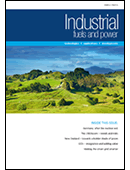DRYCON™ – dry bottom ash handling delivering reduced operating costs and improved efficiency
Jeff Hudson, Managing Director of Clyde Bergemann Materials Handling Ltd, gives an overview of an new approach to dry bottom ash handling that holds the promise of impressive benefits to thermal power plant operators.
Power plants are increasingly operating in a more competitive climate and in a world short of mineral resources, coal continues to be the raw materials of choice and correspondingly by-products from coal combustion are increasing. Stricter regulations and a heavier legislative burden coupled with increasing environmental awareness have made the operation of power plants more complicated and expensive. Resultant higher transport and disposal costs associated with waste and combustion by-products mean that the power industry must look for solutions to minimise the environmental impact. Reutilisation of bottom ash from coal combustion is already showing positive results with its use in structural embankments and drainage systems. When mixed with fly ash it may also be used in the cement industry. A new dry bottom ash handling system continues to burn the bottom ash during the extraction and cooling phase – passing ambient air, instead of water, over the ash. Known as DRYCON™, the system not only minimises emissions and non-recyclable waste products but also delivers increased boiler efficiency, due to the improved burning of the ash.
Dry vs wet
Traditionally bottom ash has been handled in a wet condition via established technologies such as impounded hoppers or submerged scraper conveyors. The use of water as opposed to air as a cooling agent can incur additional costs. Factors such as water treatment, corrosion damages, higher disposal costs and environmental problems as well as the higher costs to maintain must all be considered.
Using a dry system means that no water is required in the process therefore no water treatment is necessary. Reduced emissions and returning heat energy to the boiler resulting in lower coal usage and so with lower costs for emission trading are also highly beneficial to plant operators. The table below shows the main factors which compare between the two methods of conveying:
Cost scenario – DRYCON™ vs SSC
The following is an economic study of the relative costs of a DRYCON™ bottom ash system against the more traditional Submerged Scraper Conveyor (SSC) technology. The study is based on a typical European base load pulverised coal fired power plant of 800MW operating with imported coal. The economic factors assumed for the study assume depreciation over 10 years and the interest on loan capital of 12 per cent.
Looking at the investment costs, it can been seen that although the DRYCON™ is slightly more expensive than the SSC on a unit basis and the cost of associated crushing equipment is similar, these are offset by simpler transport and storage equipment and the lack of requirement of water treatment equipment such as pumps, filters, heat exchangers etc.
Considering the consumptions on an annual basis, it can be seen that due to the DRYCON™ roller design, the friction losses are significantly reduced and therefore have a positive effect on energy consumption and resultant wear. In addition, the SSC requires the provision of cooling water. At the associated costs indicated, it can be seen that the annual operating costs of the DRYCON™ are approximately 47 per cent of those of the SSC. As discussed earlier, the DRYCON™ captures waste energy from the incomplete combustion of the bottom ash and introduces it into the boiler as pre –heated air at approximately 450 degrees C. This results in an overall increase in boiler efficiency of between 0.15 and 0.5 per cent.
The bottom ash resulting from the DRYCON™ is a sellable product as it has good properties for the construction industry because it is low in carbon and it is dry and easily handled. In comparison the wet bottom ash from the SSC is generally disposed of and has the potential to impact the environment through water consumption and contamination.
For the concluding calculations, an increase of boiler efficiency of 0.15 per cent is assumed and no provision has been made for income from the sale of dry DRYCON™ bottom ash or costs for the disposal of wet SSC ash.
For the relative rate on investment the following calculation has been used.
Relative ROI = ((Gain from in investment from DRYCON™ over SSC) – (Cost difference between DRYCON™ and SSC))/(Cost difference between DRYCON™ and SSC)
In Scenario 1, it is assumed that the increase in efficiency of 0.15 per cent is used to generate an additional 9461 MW per annum (0.15% x 800MW x 7884hrs).
((9,460,800 kWh x 0.10 €/kwh) – ((€1,100,000 + €47,279) – (€852,500 + €100,065))) / ((€1,100,000 + €47,279) – (€852,500 + €100,065))
= 3.86 per year or 3.11 months
In Scenario 2, it is assumed that the same amount of power is produced but the increase in efficiency of 0.15 per cent is used to save 3514t of coal (0.15% x 297.2tph x 7884hrs).
((3,514 tonnes x 100 €/tonne) – ((€ 1,100,000 + €47,279) – (€852,500 + €100,065))) /
((€ 1,100,000 + € 47,279) – (€ 852,500 + € 100,065))
= 0.80 per year or 14.91 months
No Responses
Leave a Reply
Make sure you enter the * required information where indicated.
You must be logged in to post a comment.

 Click here to read the Q4 2011 Issue of Industrial Fuels & Power
Click here to read the Q4 2011 Issue of Industrial Fuels & Power 

